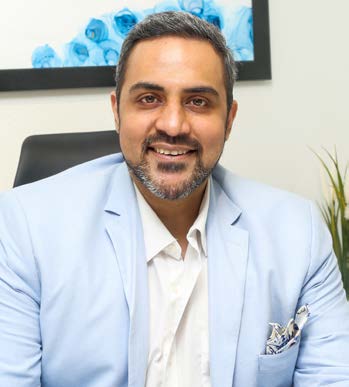Dermatologist
PLATELET RICH PLASMA (PRP) FOR HAIR LOSS

Dr Aseem Sharma Chief Dermatologist Skin Saga Centre for Dermatology, Mumbai 10 years in practice
Dr Aseem Sharma, MD, DNB, MBA, FMUHS, is a retired Squadron Leader of the Indian Air Force and the Army Medical Corps. He is the Honorary Secretary of Indian Association of Dermatologists, Venereologists and Leprologists (IADVL) Maharashtra and Member of the IADVL PRP Taskforce. Till date, he has written over 100 articles and chapters and has given more than 300 presentations on national, international, and virtual platforms. He was an Assistant Professor of Dermatology at the LTM Medical College and General Hospital, Mumbai.
Know more from Dr Sharma about PRP for hair loss:
Who is a good candidate for PRP for Hair Loss? How do you determine if this is the ideal procedure?
In terms of hair loss, PRP can be given to any patient who has a mild to moderate grade of alopecia, in combination with other treatments. It can be given alongside medical therapy or as a boost to existing treatment, but must be avoided as a standalone therapy or monotherapy. It can also be given in other forms of non-hormonal alopecia to strengthen and nourish the hair follicle. My approach involves assessing the grade and severity of alopecia, the underlying factors and diagnosing the type of alopecia. I then assess the patient and try to marginalize his/her expectations to make them more realistic.That, in short, is how I determine whether PRP is the ideal procedure for a particular patient or not.
How can best results be derived from this treatment, and what is the technique involved?
Optimal results can be derived for PRP once the patient has undergone a minimum of three sessions at monthly intervals; the tentative timeframe for the said results is three months. Peak effects of the procedure are seen after a sixmonth period, on completion of six sessions, following which, quarterly or half-yearly maintenance sessions are done. My technique involves a standard, double spin method with a large blood draw to achieve optimum platelet concentration. This advanced method has been standardised by our research group (IADVL National PRP Taskforce) with a cumulative experience of over 3,000 patients between us.
What is the recovery time for a patient who undergoes PRP for hair loss?
Unlike most aesthetic procedures, PRP has a fairly low downtime, making it an exceptional therapeutic option for those with busy schedules and face-to-face commitments. Patients recover from a PRP session in under 24 hours, with minimal post-procedure care.
Any contraindications that one should be aware of?
Relative contraindications include a history of bleeding disorders, consumption of drugs that reduce or affect platelet counts, and a fear of injections.
One challenging case study that you have dealt with for this treatment.
I had a patient walk in to my clinic a few years ago with hair loss, which was diagnosed by his family physician as androgenetic alopecia (hormonal patterned hair loss) and was already treated with three sessions of PRP! Upon detailed history and examination, to my horror, he had a form of scarring alopecia (lichen planopilaris) which had been misdiagnosed and he had lost a lot of hair follicles in the process. I did a biopsy and confirmed my findings. Needless to say, he had no faith in PRP or any procedure, for that matter.I counseled him, explained that we would need to control the disease to prevent him from going irreversibly bald and then transplant the bald areas to complete the treatment. Within the next year, we managed to gain control of his disease activity and prepared his scalp for hair transplantation by giving him three sessions of PRP. Even during the procedure, he exclaimed how structured the treatment was and how he did not understand what treatment he had taken earlier. Cut to 2021, his transplant has been successful and he still visits for booster sessions and to top up his medications and topicals. This case shows the importance of establishing a hard diagnosis before jumping into treatment modalities, and also how PRP wears many, many hats!